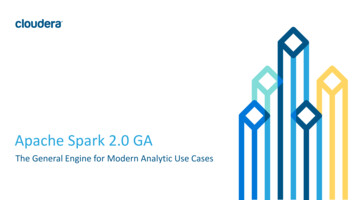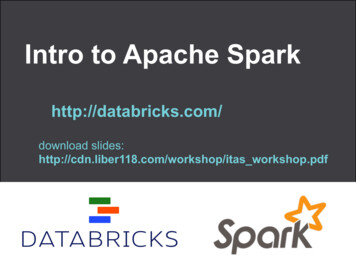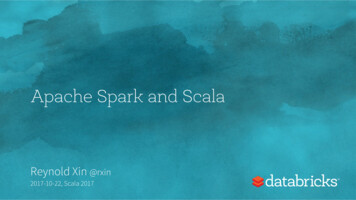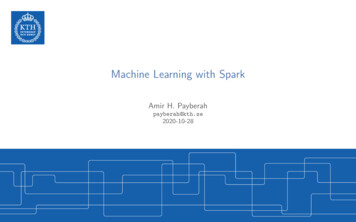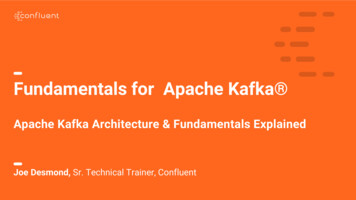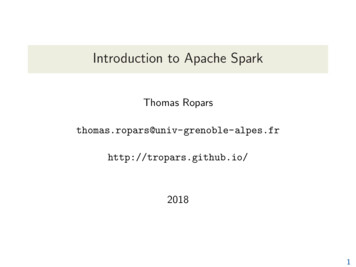
Transcription
Introduction to Apache SparkThomas ropars.github.io/20181
ReferencesThe content of this lectures is inspired by: The lecture notes of Yann Vernaz. The lecture notes of Vincent Leroy. The lecture notes of Renaud Lachaize. The lecture notes of Henggang Cui.2
Goals of the lecture Present the main challenges associated with distributedcomputing Review the MapReduce programming model for distributedcomputingI Discuss the limitations of Hadoop MapReduce Learn about Apache Spark and its internals Start programming with PySpark3
AgendaComputing at large scaleProgramming distributed systemsMapReduceIntroduction to Apache SparkSpark internalsProgramming with PySpark4
AgendaComputing at large scaleProgramming distributed systemsMapReduceIntroduction to Apache SparkSpark internalsProgramming with PySpark5
Distributed computing: DefinitionA distributed computing system is a system including severalcomputational entities where: Each entity has its own local memory All entities communicate by message passing over a networkEach entity of the system is called a node.6
Distributed computing: MotivationThere are several reasons why one may want to distribute data andprocessing: ScalabilityI The data do not fit in the memory/storage of one nodeI The processing power of more processor can reduce the timeto solution Fault tolerance / availabilityI Continuing delivering a service despite node crashes. LatencyI Put computing resources close to the users to decrease latency7
Increasing the processing powerGoals Increasing the amount of data that can be processed (weakscaling) Decreasing the time needed to process a given amount of data(strong scaling)Two solutions Scaling up Scaling out8
Vertical scaling (scaling up)IdeaIncrease the processing power by adding resources to existingnodes: Upgrade the processor (more cores, higher frequency) Increase memory capacity Increase storage capacityPros and Cons9
Vertical scaling (scaling up)IdeaIncrease the processing power by adding resources to existingnodes: Upgrade the processor (more cores, higher frequency) Increase memory capacity Increase storage capacityPros and Cons §§Performance improvement without modifying the applicationLimited scalability (capabilities of the hardware)Expensive (non linear costs)9
Horizontal scaling (scaling out)IdeaIncrease the processing power by adding more nodes to the system Cluster of commodity serversPros and Cons10
Horizontal scaling (scaling out)IdeaIncrease the processing power by adding more nodes to the system Cluster of commodity serversPros and Cons§ Often requires modifying applicationsLess expensive (nodes can be turned off when not needed)Infinite scalability10
Horizontal scaling (scaling out)IdeaIncrease the processing power by adding more nodes to the system Cluster of commodity serversPros and Cons§ Often requires modifying applicationsLess expensive (nodes can be turned off when not needed)Infinite scalabilityMain focus of this lecture10
Large scale infrastructuresFigure: Google Data-centerFigure: Barcelona SupercomputingCenterFigure: Amazon Data-center11
Programming for large-scale infrastructuresChallenges PerformanceI How to take full advantage of the available resources?I Moving data is costly How to maximize the ratio between computation andcommunication? ScalabilityI How to take advantage of a large number of distributedresources? Fault toleranceI The more resources, the higher the probability of failureI MTBF (Mean Time Between Failures) MTBF of one server 3 years MTBF of 1000 servers ' 19 hours (beware: over-simplifiedcomputation)12
Programming in the CloudsCloud computing A service provider gives access to computing resourcesthrough an internet connection.Pros and Cons13
Programming in the CloudsCloud computing A service provider gives access to computing resourcesthrough an internet connection.Pros and Cons Pay only for the resources you useGet access to large amount of resourcesI Amazon Web Services features millions of servers§VolatilityI Low control on the resourcesI Example: Access to resources based on biddingI See ”The Netflix Simian Army”§Performance variabilityI Physical resources shared with other users13
Architecture of a data centerSimplifiedSwitch: storage: memory: processor14
Architecture of a data centerA shared-nothing architecture Horizontal scaling No specific hardwareA hierarchical infrastructure Resources clustered in racks Communication inside a rack is more efficient than betweenracks Resources can even be geographically distributed over severaldatacenters15
A warning about distributed computingYou can have a second computer once you’ve shown youknow how to use the first one. (P. Braham)Horizontal scaling is very popular. But not always the most efficient solution (both in time andcost)Examples Processing a few 10s of GB of data is often more efficient ona single machine that on a cluster of machines Sometimes a single threaded program outperforms a cluster ofmachines (F. McSherry et al. “Scalability? But at whatCOST!”. 2015.)16
AgendaComputing at large scaleProgramming distributed systemsMapReduceIntroduction to Apache SparkSpark internalsProgramming with PySpark17
Summary of the challengesContext of execution Large number of resources Resources can crash (or disappear)I Failure is the norm rather than the exception. Resources can be slowObjectives Run until completionI And obtain a correct result :-) Run fast18
Shared memory and message passingTwo paradigms for communicating between computing entities: Shared memory Message passing19
Shared memory Entities share a global memory Communication by reading and writing to the globally sharedmemory Examples: Pthreads, OpenMP, etc20
Message passing Entities have their own private memory Communication by sending/receiving messages over a network Example: MPI21
Dealing with failures: CheckpointingCheckpointingAppckpt 1ckpt 2ckpt 3ckpt 422
Dealing with failures: CheckpointingCheckpointingAppckpt 1ckpt 2ckpt 3ckpt 4 Saving the complete state of the application periodically22
Dealing with failures: CheckpointingCheckpointingAppckpt 1ckpt 2ckpt 3ckpt 4 Saving the complete state of the application periodically Restart from the most recent checkpoint in the event of afailure.22
About checkpointingMain solution when processes can apply fine-grained modificationsto the data (Pthreads or MPI) A process can modify any single byte independently Impossible to log all modificationsLimits Performance cost Difficult to implement The alternatives (passive or active replication) are even morecostly and difficult to implement in most cases23
About slow resources (stragglers)Performance variations Both for the nodes and the network Resources shared with other usersImpact on classical message-passing systems (MPI) Tightly-coupled processesI Process A waits for a message from process B beforecontinuing its computationDo some computationnew data Recv(from B) /*blocking*/Resume computing with new dataFigure: Code of process A. If B is slow, A becomes idle.24
The Big Data approachProvide a distributed computing execution framework Simplify parallelizationI Define a programming modelI Handle distribution of the data and the computation Fault tolerantI Detect failureI Automatically takes corrective actions Code once (expert), benefit to allLimit the operations that a user can run on data Inspired from functional programming (eg, MapReduce) Examples of frameworks:I Hadoop MapReduce, Apache Spark, Apache Flink, etc25
AgendaComputing at large scaleProgramming distributed systemsMapReduceIntroduction to Apache SparkSpark internalsProgramming with PySpark26
MapReduce at GoogleReferences The Google file system, S. Ghemawat et al. SOSP 2003. MapReduce: simplified data processing on large clusters, D.Jeffrey and S. Ghemawat. OSDI 2004.Main ideas Data represented as key-value pairs Two main operations on data: Map and Reduce A distributed file systemI Compute where the data are locatedUse at Google Compute the index of the World Wide Web. Google has moved on to other technologies27
Apache Hadoop28
Apache HadoopIn a few words Built on top of the ideas of Google A full data processing stack The core elementsI A distributed file system: HDFS (Hadoop Distributed FileSystem)I A programming model and execution framework: HadoopMapReduceMapReduce Allows simply expressing many parallel/distributedcomputational algorithms29
MapReduceThe Map operation Transformation operation map(f )[x0 , ., xn ] [f (x0 ), ., f (xn )] map( 2)[2, 3, 6] [4, 6, 12]The Reduce operation Aggregation operation (fold) reduce(f )[x0 , ., xn ] [f ((x0 ), f ((x1 ), ., f (xn 1 , xn )))] reduce( )[2, 3, 6] (2 (3 6)) 1130
Hadoop MapReduceKey/Value pairs MapReduce manipulate sets of Key/Value pairs Keys and values can be of any typesFunctions to apply The user defines the functions to apply In Map, the function is applied independently to each pair In Reduce, the function is applied to all values with the samekey31
Hadoop MapReduceAbout the Map operation A given input pair may map to zero or many output pairs Output pairs need not be of the same type as input pairsAbout the Reduce operation Applies operation to all pairs with the same key 3 steps:I Shuffle and Sort: Groups and merges the output of mappers bykeyI Reduce: Apply the reduce operation to the new key/value pairs32
A first MapReduce programWord CountDescription Input: A set of lines including wordsI Pairs line number, line content I The initial keys are ignored in this example Output: A set of pairs word, nb of occurrences Input 1, ”aaa bb ccc” 2, ”aaa bb” Output ”aaa”, 2 ”bb”, 2 ”ccc”, 1 33
A first MapReduce programWord Countmap(key, value): /* pairs of {line num, content} */foreach word in value.split():emit(word, 1)reduce(key, values): /* {word, list nb occurences} */result 0for value in values:result valueemit(key, result) /* - {word, nb occurences} */34
A first MapReduce programWord Count1, ”aaa bb ccc”2, ”bb bb d”3, ”d aaa bb”4, ”d”map”aaa”, 1”bb”, 1”ccc”, 1”bb”, 1”bb”, 1”d”, 1”d”, 1”aaa”, 1”bb”, 1”d”, 1reduce”aaa”, 2”bb”, 4”ccc”, 1”d”, 3Logical representation (no notion of distribution)35
Distributed execution of Word Countnode Bnode Bnode B1, ”bb bb””bb”, 1”bb”, 3”bb”, 1node Acombnode A”aa”, 1”aa”, 32, ”aa aa””bb”, 1”bb”, 1map”aa”, 1comb”aa”, 3”bb”, 4node A1, ”aa bb”node Cuce”bb”, 1eucredmapred2, ”bb””aa”, 136
Example: Web indexDescriptionConstruct an index of the pages in which a word appears. Input: A set of web pagesI Pairs URL, content of the page Output: A set of pairs word, set of URLs 37
Example: Web indexmap(key, value): /* pairs of {URL, page content} */foreach word in value.parse():emit(word, key)reduce(key, values): /* {word, URLs} */list []for value in values:list.add(value)emit(key, list) /* {word, list of URLs} */38
Running at scaleHow to distribute data? Partitioning ReplicationPartitioning Splitting the data into partitions Partitions are assigned to different nodes Main goal: PerformanceI Partitions can be processed in parallelReplication Several nodes host a copy of the data Main goal: Fault toleranceI No data lost if one node crashes39
Hadoop Distributed File System (HDFS)Main ideas Running on a cluster of commodity serversI Each node has a local diskI A node may fail at any time The content of files is stored on the disks of the nodesI Partitioning: Files are partitioned into blocks that can bestored in different DatanodesI Replication: Each block is replicated in multiple Datanodes Default replication degree: 3I A Namenode regulates access to files by clients Master-worker architecture40
HDFS architectureFigure from https://hadoop.apache.org/docs/r1.2.1/hdfs design.html41
Hadoop data workflowFigure ntroduction-to-the-mapreduce-life-cycle42
Hadoop workflow: a few commentsData movements Map tasks are executing on nodes where the data blocks arehostedI Or on close nodesI Less expensive to move computation than to move data Load balancing between the reducersI Output of mappers are partitioned according to the number ofreducers (modulo on a hash of the key)43
Hadoop workflow: a few commentsI/O operations Map tasks read data from disks Output of the mappers are stored in memory if possibleI Otherwise flushed to disk The result of reduce tasks in written into HDFSFault tolerance Execution of tasks is monitored by the master nodeI Tasks are launched again on other nodes if crashed or too slow44
AgendaComputing at large scaleProgramming distributed systemsMapReduceIntroduction to Apache SparkSpark internalsProgramming with PySpark45
Apache Spark Originally developed at Univ. of California Resilient distributed datasets: A fault-tolerant abstraction forin-memory cluster computing, M. Zaharia et al. NSDI, 2012. One of the most popular Big Data project today.46
Spark vs HadoopSpark added value PerformanceI Especially for iterative algorithms Interactive queries Supports more operations on data A full ecosystem (High level libraries) Running on your machine or at scaleMain novelties Computing in memory A new computing abstraction: Resilient Distributed Datasets(RDD)47
Programming with SparkSpark Core API Scala Python JavaIntegration with HadoopWorks with any storage source supported by Hadoop Local file systems HDFS Cassandra Amazon S348
Many resources to get started https://spark.apache.org/ https://sparkhub.databricks.com/ Many courses, tutorials, and examples available online49
Starting with SparkRunning in local mode Spark runs in a JVMI Spark is coded in Scala Read data from your local file systemUse interactive shell Scala (spark-shell) Python (pyspark) Run locally or distributed at scale50
A very first example with pysparkCounting lines51
The Spark Web UI52
The Spark built-in libraries Spark SQL: For structured data (Dataframes) Spark Streaming: Stream processing (micro-batching) MLlib: Machine learning GraphX: Graph processing53
AgendaComputing at large scaleProgramming distributed systemsMapReduceIntroduction to Apache SparkSpark internalsProgramming with PySpark54
In-memory computing: InsightsSee Latency Numbers Every Programmer Should KnowMemory is way faster than disksRead latency HDD: a few milliseconds SDD: 10s of microseconds (100X faster than HDD) DRAM: 100 nanoseconds (100X faster than SDD)55
In-memory computing: InsightsGraph by P. JohnsonCost of memory decreases More memory per server56
Efficient iterative computationHadoop: At each step, data go through the disksSpark: Data remain in memory (if possible)57
Main challengeFault ToleranceFailure is the norm rather than the exceptionOn a node failure, all data in memory is lost58
Resilient Distributed DatasetsRestricted form of distributed shared memory Read-only partitioned collection of records Creation of an RDD through deterministic operations(transformations) on either:I Data stored on diskI an existing RDD59
Transformations and actionsProgramming with RDDs An RDD is represented as an object Programmer defines RDDs using TransformationsI Applied to data on disk or to existing RDDsI Examples of transformations: map, filter, join Programmer uses RDDs in ActionsI Operations that return a value or export data to the file systemI Examples of actions: count, reduce60
Fault tolerance with LineageLineage a description of a RDD The data source on disk The sequence of applied transformationsI Same transformation applied to all elementsI Low footprint for storing a lineageFault tolerance RDD partition lostI Replay all transformations on the subset of input data or themost recent RDD available Deal with stragglersI Generate a new copy of a partition on another node61
Spark runtimeFigure by M. Zaharia et al DriverI Executes the userprogramI Defines RDDs and invokesactionsI Tracks RDD’s lineage WorkersI Store RDD partitionsI Perform transformationsand actions Run tasks62
Persistence and partitioningSee ng-guide.html#rdd-persistenceDifferent options of persistence for RDDs Options:I Storage: memory/disk/bothI Replication: yes/noI Serialization: yes/noPartitions RDDs are automatically partitioned based on:I The configuration of the target platform (nodes, CPUs)I The size of the RDDI User can also specify its own partitioning Tasks are created for each partition63
RDD dependenciesTransformations create dependencies between RDDs.2 kinds of dependencies Narrow dependenciesI Each partition in the parent is used by at most one partition inthe child Wide (shuffle) dependenciesI Each partition in the parent is used by multiple partitions inthe childImpact of dependencies Scheduling: Which tasks can be run independently Fault tolerance: Which partitions are needed to recreate a lostpartition Communication: Shuffling implies large amount of dataexchanges64
RDD dependenciesFigure by M. Zaharia et al65
Executing transformations and actionsLazy evaluation Transformations are executed only when an action is called onthe corresponding RDD Examples of optimizations allowed by lazy evaluationI Read file from disk action first(): no need to read thewhole fileI Read file from disk transformation filter(): No need tocreate an intermediate object that contains all lines66
Persist an RDD By default, an RDD is recomputed for each action run on it. A RDD can be cached in memory calling persist() orcache()I Useful is multiple actions to be run on the same RDD(iterative algorithms)I Can lead to 10X speedupI Note that a call to persist does not trigger transformationsevaluation67
AgendaComputing at large scaleProgramming distributed systemsMapReduceIntroduction to Apache SparkSpark internalsProgramming with PySpark68
The SparkContextWhat is it? Object representing a connection to an execution cluster We need a SparkContext to build RDDsCreation Automatically created when running in shell (variable sc) To be initialized when writing a standalone applicationInitialization Run in local mode with nb threads nb cores: local[*] Run in local mode with 2 threads: local[2] Run on a spark cluster: spark://HOST:PORT69
The SparkContextPython shell pyspark --master local[*]Python programimport pysparksc pyspark.SparkContext("local[*]")70
The first RDDsCreate RDD from existing iterator Use of SparkContext.parallelize() Optional second argument to define the number of partitionsdata [1, 2, 3, 4, 5]distData sc.parallelize(data)Create RDD from a file Use of SparkContext.textFile()data sc.textFile("myfile.txt")hdfsData sc.textFile("hdfs://myhdfsfile.txt")71
Some transformationssee ng-guide.html#transformations map(f): Applies f to all elements of the RDD. f generates a singleitem flatMap(f): Same as map but f can generate 0 or several items filter(f): New RDD with the elements for which f return true union(other)/intersection(other): New RDD being theunion/intersection of the initial RDD and other . cartesian(other): When called on datasets of types T and U, returnsa dataset of (T, U) pairs (all pairs of elements) distinct(): New RDD with the distinct elements repartition(n): Reshuffle the data in the RDD randomly to createeither more or fewer partitions and balance it across them72
Some transformations with K,V pairs groupByKey(): When called on a dataset of (K, V) pairs, returns adataset of (K, Iterable V ) pairs. reduceByKey(f): When called on a dataset of (K, V) pairs, Mergethe values for each key using an associative and commutativereduce function. aggregateByKey(): see documentation join(other): Called on datasets of type (K, V) and (K, W), returns adataset of (K, (V, W)) pairs with all pairs of elements for each key.73
Some -programming-guide.html#actions reduce(f): Aggregate the elements of the dataset using f (takes twoarguments and returns one). collect(): Return all the elements of the dataset as an array. count(): Return the number of elements in the dataset. take(n): Return an array with the first n elements of the dataset. takeSample(): Return an array with a random sample of numelements of the dataset. countByKey(): Only available on RDDs of type (K, V). Returns ahashmap of (K, Int) pairs with the count of each key.74
An examplefrom pyspark.context import SparkContextsc SparkContext("local")# define a first RDDlines sc.textFile("data.txt")# define a second RDDlineLengths lines.map(lambda s: len(s))# Make the RDD persist in memorylineLengths.persist()# At this point no transformation has been run# Launch the evaluation of all transformationstotalLength lineLengths.reduce(lambda a, b: a b)75
An example with key-value pairslines sc.textFile("data.txt")words lines.flatMap(lambda s: s.split(’ ’))pairs words.map(lambda s: (s, 1))counts pairs.reduceByKey(lambda a, b: a b)# Warning: sortByKey implies shuffleresult counts.sortByKey().collect()76
Another example with key-value pairsrdd sc.parallelize([("a", 1), ("b", 1), ("a", 1)])# mapValues applies f to each value#without changing the ))# [(’a’, 2), (’b’, ())# [(’a’, [1, 1]), (’b’, [1])]77
Shared Variablessee ng-guide.html#shared-variablesBroadcast variables Use-case: A read-only large variable should be made availableto all tasks (e.g., used in a map function) Costly to be shipped with each task Declare a broadcast variableI Spark will make the variable available to all tasks in anefficient way78
Example with a Broadcast variableb sc.broadcast([1, 2, 3, 4, 5])print(b.value)# [1, 2, 3, 4, 5]print(sc.parallelize([0, 0]).flatMap(lambda x: b.value).collect())# [1, 2, 3, 4, 5, 1, 2, 3, 4, 5]b.unpersist()79
Shared VariablesAccumulator Use-case: Accumulate values over all tasks Declare an Accumulator on the driverI Updates by the tasks are automatically propagated to thedriver. Default accumulator: operator ’ ’ on int and float.I User can define custom accumulator functions80
Example with an Accumulatorfile sc.textFile(inputFile)# Create Accumulator[Int] initialized to 0blankLines sc.accumulator(0)def splitLine(line):# Make the global variable accessibleglobal blankLinesif not line:blankLines 1return line.split(" ")words file.flatMap(splitLine)print(blankLines.value)81
additional slides82
Job schedulingMain ideas Tasks are run when the user calls an action A Directed Acyclic Graph (DAG) of transformations is builtbased on the RDD’s lineage The DAG is divided into stages. Boundaries of a stage definedby:I Wide dependenciesI Already computed RDDs Tasks are launch to compute missing partitions from eachstage until target RDD is computedI Data locality is taken into account when assigning tasks toworkers83
Stages in a RDD’s DAGFigure by M. Zaharia et al84
I Hadoop MapReduce, Apache Spark, Apache Flink, etc 25. Agenda Computing at large scale Programming distributed systems MapReduce Introduction to Apache Spark Spark internals Programming with PySpark 26. MapReduce at Google References The Google le system, S. Ghemawat et al. SOSP 2003. M
